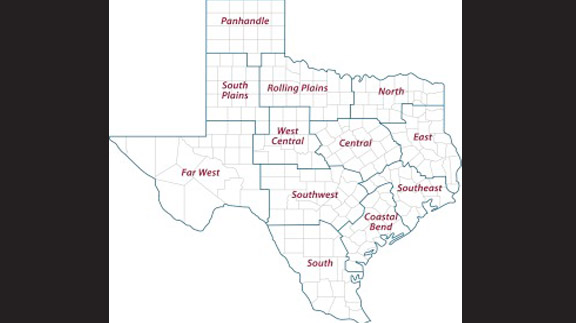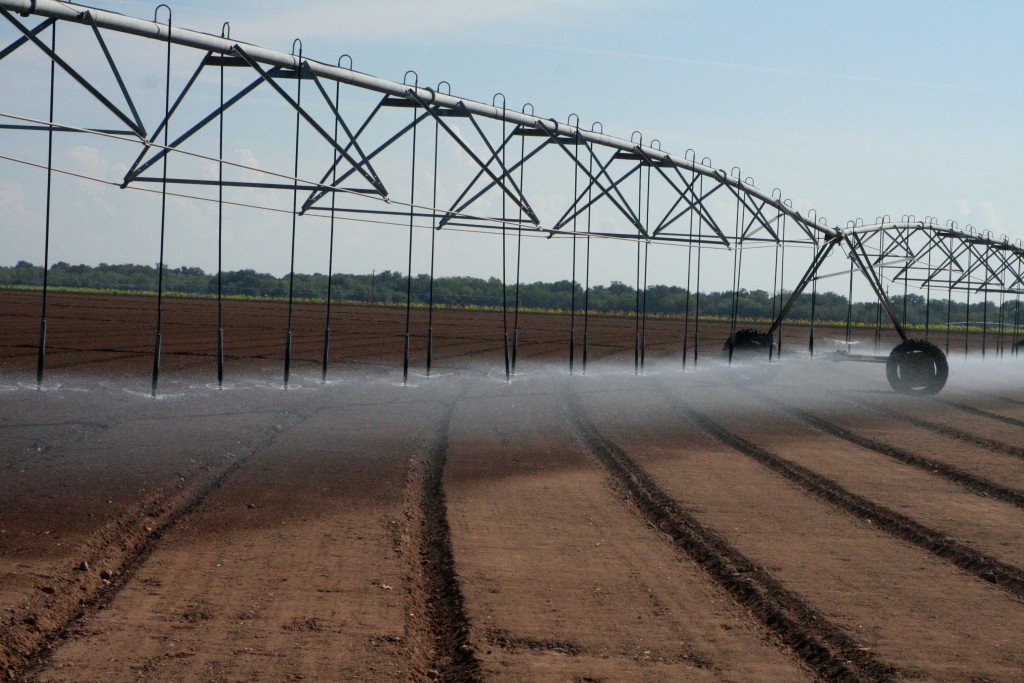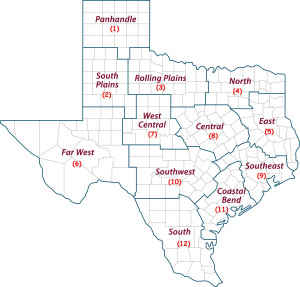Farm & Ranch
Texas crop, weather report for Sept. 29, 2015

By: Robert Burns
Despite heat, drought, Winter Garden growers in better shape this year
Writer: Robert Burns, 903-834-6191, [email protected]
COLLEGE STATION – Despite hotter-than-normal fall temperatures and no rain for three months, Texas Winter Garden growers are in surprisingly good shape, said Dr. Larry Stein, Texas A&M AgriLife Extension Service horticulturist based in Uvalde.
Water levels in the aquifers that supply irrigation water to the Winter Garden area – mainly the Edwards and the Carrizo-Wilcox – have not been recharged to pre-drought levels by rains last winter and spring, but they are in much better shape than they have been for years, Stein said. This has resulted in a return of water to many formerly dry wells, allowing for the planting of fields that had no water last year.
Download or preview a two-minute MP3 audio version of this report
Cooler air temperatures would also help with germination for crops like spinach, which are being planted now, Stein said.
Air temperatures have been in the upper 90s, and they are expected to hold that for the rest of the week,” he said. “Now they are talking about a break in the temperatures this weekend, then things should cool down during the days as well.”
Stein was also optimistic about the wetter-than-normal fall that most likely will come because of an exceptionally strong El Niño this year.
“There are a lot of people counting on it,” he said.
The Texas Winter Garden region is one of the major U.S. production areas of irrigated vegetables such as cabbage, spinach, onions, cucumbers and melons, along with pecans, according to Stein. The region lies southwest of San Antonio and is comprised mainly of seven counties, Bexar, Medina, Uvalde, Dimmit, Frio, Atascosa and Zavala. The area has been particularly hard hit by drought over the last seven years.
AgriLife Extension district reporters compiled the following summaries:
Central: Soil moisture, rangeland, pastures and crops overall were rated as being in fair condition. Livestock were generally in good condition. The region remained dry, and pastures were declining. Farmers needed rain for planting small grains. Cotton harvesting was nearly completed. Producers were taking their last cutting of hay. Pecans looked good; harvesting early varieties was expected to begin in the next couple of weeks.
Coastal Bend: Much of the region received some rain, which slightly improved the soil moisture profile. Harvesting of all crops drew to a close, with only a little cotton left in the fields. The small amount of sesame grown was also being harvested. Ranchers were either preparing to plant or already planting winter pastures. Armyworms were infesting hay fields. The fall calving season was ongoing, and cows were in really good shape.
East: Conditions continued to deteriorate; all counties needed rain. More counties reported short or very short subsoil and topsoil moisture. Pastures were rapidly drying out. Pond and creek water levels were dropping. Non-irrigated fall vegetables were in decline. Hay production halted for all practical purposes. Some producers were waiting for rain before committing to planting winter pastures, while others were preparing to plant dry. The declining pastures meant some producers had to put out hay for cattle. Some Trinity County producers were buying hay from out of county. Cattle were in good condition. Producers continued to wean calves and cull cows. Area cattle markets were weaker. Some cattle producers were planning to hold on to weaned calves for a while in hopes the market will improve. Fall calving season was underway. Horn flies were still abundant and increasing in some areas. Upshur County continued feral hog control efforts.
Far West: The entire region received some much-welcomed rain and slightly cooler temperatures. Pastures and rangeland conditions varied from very poor to fair. Topsoil and subsoil moisture was adequate to short. Farmers were stripping cotton and taking the sixth cutting of alfalfa. Cattle were in good condition, and ranchers were shipping spring-born calves. Pawnee pecans shuck opening was 50 percent, while Western pecans showed no shuck separation at all.
North: The region remained dry, and topsoil moisture ranged from very short to adequate. Temperatures were cooler for the most part, consistently in the low-60s during the night and about 90 degrees during the day. Some winter pastures were planted, but the plantings were in desperate need of moisture to promote emergence. In some areas, wheat planting for grain will not be done until late October or early November. All corn and grain sorghum was harvested, but yields were far below average due to late planting caused by excessive spring rains. Though grazing conditions declined, cattle remained in good shape. Cattle prices were dropping, which made for hard decisions for producers at weaning time. Wild hogs were still causing damage. Horn fly numbers spiked. Armyworms were a persistent problem in some areas.
Panhandle: The region had unseasonably warm weather. Some areas received showers, but a good general rain was needed throughout the region. Soil moisture was rated as mostly short. Collingsworth County received enough rain to slow harvesting activities and improve soil moisture. Peanuts were being dug and set to dry before thrashing. Most wheat was emerged and looked good after the rains. Deaf Smith County producers were still irrigating corn and grain sorghum fields. Silage producers were chopping as rapidly as possible, trying to get all the hailed-out fields — as well as the undamaged fields — harvested in a timely fashion. Crop dusters were still flying over sorghum fields trying to control sugarcane aphid. Corn for grain was coming on very quickly after rains of 0.5 inch to 2 inches. Grain sorghum fields were nearly ready for harvest. Many Deaf Smith farmers were waiting for corn to be ready for harvest before harvesting sorghum. Sunflowers that weren’t damaged too severely by August hailstorms were ready for harvest. Winter wheat growers were slowly planting, trying to avoid damage from the persistently high grasshopper populations. Hemphill County was in need of a good soaking rain. Topsoil moisture was not good enough to sow winter wheat. Cattle were in excellent shape going into the late fall and winter months. Many cow-calf producers were weaning calves; some planned to winter their calves on wheat and or grass and sell next spring. Others were taking calves to market as soon as they were weaned. Sherman County received three inches of rain, which delayed harvesting a few more days.
Rolling Plains: Temperatures ranged from the mid-60s to high-90s. The hot, dry weather caused some cotton plants to begin dropping fruit. Early planted cotton was still in good condition, but later-planted cotton was severely stressed. Pastures and rangeland were turning brown. Ranchers increased supplemental feeding and moved cattle to pastures that still had a little grazing left. Farmers continued to plant winter wheat in hopes they will get some moisture soon to get the crop started. Livestock were in good condition. The wildfire threat increased as recent storms brought lightning but little moisture. Rain was needed to maintain reservoirs, lakes and stock-water tanks.
South: Fall weather came to the region, with daytime temperatures still a bit hot, but nights in the 70s. In the northern part of the region, farmers were preparing fields for planting of winter oats and wheat. In Frio County, cotton harvesting continued, peanuts were irrigated and Bermuda grass hay was baled. La Salle County got some rain, but in Live Oak County, hot and dry conditions continued. Cattle remained in fair condition but were beginning to decline as pastures dried out. Soil moisture was very short in McMullen and Frio counties, short in Live Oak County and adequate in Atascosa County. In the eastern part of the region, Jim Wells County producers were waiting on the last few cotton fields to mature to finish harvesting. In Kleberg and Kenedy counties, cotton harvesting was close to being wrapped up. Soil moisture was adequate in Jim Wells County and short to adequate in Kleberg and Kenedy counties. In the western part of the region, the hot, dry weather was favorable for cotton harvesting. However, wheat and oat planting was delayed due to the dry conditions. Some producers with irrigation capability were applying preplant water to plant wheat and oats. Spinach planting was expected to begin by the middle of next week. Cabbage planting was active, with some early planted fields progressing well. Soil moisture was short to very short throughout the western counties. In the southern part of the region, rains increased forage production and improved rangeland and pastures. In Cameron County, fall corn and vegetables were progressing well with no irrigation needed. In Hidalgo County, wet fields hampered the harvesting of the last of the cotton and stalk destruction. In Starr County, fall vegetable planting preparations continued. Soil moisture was surplus in Cameron County, and adequate in Hidalgo and Starr counties.
South Plains: Floyd County producers received light rains that should help grasses and pastures. The grain harvest was going strong, and the cotton harvest was expected to start in about 10 days to two weeks. In Cochran County, recent rains improved subsoil and topsoil moisture. Producers there continued to harvest cotton, corn, peas, peanuts and sorghum crops. Pastures and rangeland conditions also improved with the moisture. Most of Crosby County also received rain, with accumulations ranging from a trace to as much as 2 inches in isolated areas. Some Crosby County producers began to defoliate cotton. Most of the county’s corn was harvested, with only a few fields left to dry down. Lubbock County had spotty showers, and producers were applying defoliants to selected fields. The grain harvest continued, and some producers began planting winter wheat. In Scurry County, the weather was warm and dry.
Southeast: Soil moisture varied was but was mostly very short to short, with short being the most common rating. Rangeland and pastures were rated fair to very poor, with fair ratings the most common. Walker County remained very dry. Montgomery County had a few showers, but they provided little relief to the dry conditions. Waller County farmers continued to cut hay. In Fort Bend County, cotton picking was ongoing, with yields lower than expected. Cotton yields were expected to be lower than average. Livestock were in good condition.
Southwest: Dry conditions persisted, and there was no rain forecasted going into October. Pasture grasses were plentiful but becoming very dry. Farmers were hoping for a wet winter to boost crops and ready fields for planting winter grain and pastures. Some were planting in dry soils hoping for rain so they will have early winter grazing. As the drought worsened, some were feeding hay already. Cotton harvesting neared completion with good yields reported. Fall weaning of calves and culling of herds continued.
West Central: Hot, dry, windy days with cool nights have continued. Daytime temperatures remained in the mid- to upper-90s. Some areas had scattered showers, but more rain was needed in all areas. The danger of rangeland wildfire was high. Farmers increased field activities and preparations for fall small-grain planting. A few producers were dry-planting winter pastures, but most were waiting on rain. Rangeland and pastures continued to decline due to summer heat and lack of moisture. Cotton farmers were gearing up for the cotton harvest by readying equipment and applying harvest aids. Livestock remained in fair condition. Producers started some supplemental feeding of livestock. Cattle markets softened. Pecan growers prepared for harvest.
-30-
Find more stories, photos, videos and audio at http://today.agrilife.org
Farm & Ranch
Hazards of Backyard Poultry

By Barry Whitworth, DVM
Having backyard poultry is a popular agriculture enterprise. According to the United States Department of Agriculture, 0.8 percent of all households in the United States have chickens. People keep chickens for a variety of reasons with table eggs being one of the more common reasons.
Unfortunately, some of these poultry producers are not aware of the hazards that come with keeping poultry because many times they carry pathogens but appear healthy.
Chickens are carriers of several zoonotic diseases. These are diseases that can be passed from animals to humans. According to a recent survey in Pennsylvania, a majority of backyard poultry producers were aware of the dangers of avian influenza. However, this study also revealed that far fewer producers were aware of the risk of possible exposure to Salmonella and Campylobacter.
The lack of knowledge about the hazards of raising poultry likely contributes to the continued issues of Salmonella outbreaks associated with backyard poultry. In 2023, the Centers for Disease Control and Prevention reported 1,072 illnesses of Salmonella linked to backyard poultry, and 272 of those patients required hospitalization. Oklahoma reported 43 individuals with the disease.
To read more, pick up a copy of the April issue of NTFR magazine. To subscribe by mail, call 940-872-5922.
Farm & Ranch
Ag Elsewhere: Wyoming

By Tressa Lawrence
Babies are tucked away in every nook and cranny. Many ranchers across Wyoming have baby animals popping up all over this time of year.
Farm & Ranch
Ag Elsewhere: Montana

By Lindsey Monk
Another load of grain in to keep feeding the calves until the green grass can really start popping.
-

 Country Lifestyles1 year ago
Country Lifestyles1 year agoScott & Stacey Schumacher: A Growth Mindset
-

 Equine7 months ago
Equine7 months agoThe Will to Win
-

 Country Lifestyles7 years ago
Country Lifestyles7 years agoStyle Your Profile – What your style cowboy hat says about you and new trends in 2017
-

 Country Lifestyles4 years ago
Country Lifestyles4 years agoAmber Crawford, Breakaway Roper
-

 HOME7 years ago
HOME7 years agoGrazing North Texas – Wilman Lovegrass
-

 Country Lifestyles7 years ago
Country Lifestyles7 years agoDecember 2016 Profile, Rusty Riddle – The Riddle Way
-

 Country Lifestyles8 years ago
Country Lifestyles8 years agoJune 2016 Profile – The man behind the mic: Bob Tallman
-

 Outdoor9 years ago
Outdoor9 years agoButtercup or Primrose?








